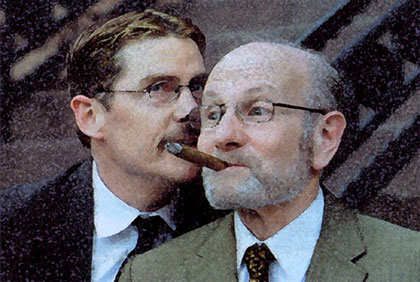One of the questions that came up after the series of readings of SECRETS: The Sigmund Freud – Carl Jung Affair in the spring of 2006, especially for those who knew something but not a lot about these two revolutionary thinkers of the 20th century, was : Why were Freud and Jung so important? What do they do that made them so famous and influential nearly 100 years later?
In other words, people were asking, more for clarification than for opposition, why do a play about these men at all? What in their story and in their personal and professional lives – is really worth telling?
In a nutshell, Freud and Jung were – and are – important because they uncovered and discovered that the invisible world is real. More than that, they began to explore and understand how the invisible world plays into and influences the everyday lives of millions of people, then and now.
By “invisible world’ – my phrase, not theirs – Freud and Jung mean the reality of the unconscious side of the psyche. Before them, when dealing with hysteria, depression, addictive behavior, mental illness and even sociopathic attacks by individuals against society, most of the focus was on the external, environment cause of such problematic conditions.
Mentally ill people were either not treated at all or locked up into asylums without any hope of cure or returning to play a positive role in their environments. Mental illness as one extreme, and unhappy lives on the other, were thought to be functions of social ills or environmental conditions.
What Freud and Jung did, with revolutionary insight, was to identify and explore the conditions of the invisible world, the unconscious dimension to the human mind and soul. Freud and Jung began to realize that traumatic events of the past were pushed down and buried in the unconscious, but were not put away to rest forever. Their task as therapist and as theoretician was to draw out the secrets – unlock frozen emotions, have the patients tell and claim a story that they would rather kept dark and boxed up forever.
If a child was beaten, mistreated or abused as a 3, 4, or 5 year old, the wounds and scars did not get buried forever or thrown into the scrap heap of the past. Those feelings, emotions, fears, worries, resentments were stored underground, out of sight and awareness of every day waking consciousness, but did not disappear. That which the patients resisted and resent, they retained.
Underground, these emotions and feelings grew into issues and complexes – what we might call baggage today – and could influence the actions, perspectives and ways of behaving into the adult life. When traumas of the past went underground or “under the radar,” they would often take on an energy and life of their own.
Therefore, when a seemingly normal person would erupt at the criticism of an employer, spouse or policeman, Freud and Jung began to realize that the cause of that behavior was not in the immediate physical environment -- it was a function of something on the unconscious that was still alive and in play today.
So, for Freud and Jung, the inner life, the hidden recesses of the mind, were just as real as any object or condition in the physical world. The source of distress, anxiety or depression (or worse) was in the inner life of the patient, so far hidden and buried that the person could conceivably not know it was there and active himself.
This “shadow” side, this secret, repressed constellation of hard, unresolved feelings and resentments, needed to be brought up into the light of consciousness for there to be any hope of release, relief or cure. Both Freud and Jung believed that no cure was possible unless and until they could get at the patient’s secret.
Therefore, they attempted to set a confidential, safe and secure environment so that the patient could relax, trust and open up. They looked to dreams for clues for what was happening on the “invisible” but real side of the psyche. Through their work with patients, Freud and Jung began to infer or make hypotheses about the inner, hitherto unseen, nature of human reality.
They wrote about WHY people behaved as they did. In that sense, Freud and Jung were detectives of the soul. In each patient, there was a riddle or a mystery to discover. Like Sherlock Holmes did with criminals, Freud and Jung looked for clues, slips of the tongue or dreams, for example that shed light on what was going on in the depths of the patient’s mind.
Freud and Jung began to open doors that had previously been locked or ignored. For them, what was happening beneath the surface was as important, if not more important, than what could be seen or perceived by the physical senses. They understood that what was happening way down deep told the true story of the individual’s life history.
In seeking the truth, Freud and Jung knew that the inner invisible world, one that could not be measured or explained by physical devices, was where the ultimate truth really would be found. This discovery in the early 1900's impacted almost every aspect of 20th century thinking. After Jung and Freud, the novelist, the playwright, the painter, the composer, this historian HAD to look at the interior landscape of a personality in order to fully express the reality of that person. Just the physical facts of a person’s life were not enough to tell the whole, truthful story. Dostoevksy began writing what could be called the psychological novel in the late 1800s, but with Freud and Jung, it became imperative for the writer to have an understanding about the nature and the depths of a character’s complexes. The inner life of the character played OUT, as much if not more than the environment playing IN.
Those hidden, buried, “invisible” aspects of a person often motivated and drove the individual into action of everyday life. Freud and Jung were among the first to know and to write about -- to speak about – what used to be kept secret and under cover.
Jung himself, in his autobiography MEMORIES, DREAMS AND REL.ECTIONS (as told to Aniela Jaffe), stressed that the outer events of his life were rather ordinary and unremarkable. What was important to him was the under-the-surface activity, the rhizomes under the ground. The unseen, invisible to the naked eye happenings – that was where the truth really could be found.
Today, we tend to take an anti-depressant like Prozac, Paxil or Wellbuton when we feel upset, anxious or depressed. The pill pushing doctors want to raise our serotonin levels, and bring us back to balance. Maybe that can work for a while. Maybe the pill can bring some temporary relief.
But the real work – as Freud and Jung would urge us – is to work on our inner selves. To bring up the past and see it in a different light. To examine and resolve issues rather than keep them hidden and secret in some faraway distant vault.
Freud and Jung were important then, and are still important today, because they declared the invisible dimension to be just as real and valid as the things we can buy, accumulate, protect and defend. For me, Freud and Jung were contemporary reminders to “Know Thyself.” As Freud says in the play, “You can get away WITH a secret. You can’t get away FROM it.”
In an early scene in SECRETS: The Sigmund Freud –Carl Jung Affair, Carl Jung credits and complements Sigmund Freud:
“You were the first one walk on the dark side of the moon.”
Freud chuckles graciously, happy to have found someone who sees the issues as he does. Freud knew he had his man – or did he?
Ken Wydro July 3, 2006




